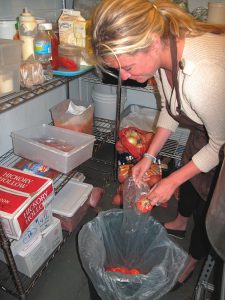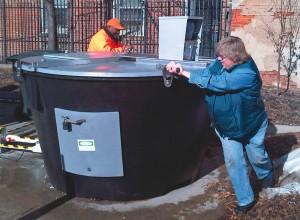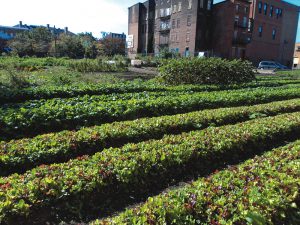Vendors generate almost 40 tons/year of food scraps, which are now composted on site with shredded wax corrugated and wood chips.
Michelle Balz
BioCycle September 2012, Vol. 53, No. 9, p. 22

Vendors are provided color-coded 5-gallon buckets for food waste separation and collection. Larger containers are available if needed.
Such a food-centered market naturally begets a waste diversion program centered on composting. Facing limited space and no off-site composting options, Findlay Market installed two Earth Tub in-vessel composting units (each 3 cubic yard capacity) in 2009. The program proved successful, leading to a third Earth Tub installed this past spring to accommodate the expanding farmer’s market and additional full-time vendors. These units were funded through grants from the U.S. Department of Agriculture and the Hamilton County Recycling and Solid Waste District. “It seemed like a good opportunity to not only divert waste from the landfill but create a useful product that would help us with landscaping around the market,” says Bob Pickford, President and CEO for the Corporation for Findlay Market, who championed the idea of on-site composting.
Until 2000, Findlay Market vendors would simply toss trash out the back of vendor stalls. A City of Cincinnati employee with a truck dedicated to the market drove around picking up the waste. And with no recycling or composting there was plenty to pick up. The renovation in 2000 modernized the waste collection system with a central waste compactor. Eventually cardboard recycling was added, followed by commingled recycling and on-site composting.

The market has three Earth Tub on-site composting units. It takes three weeks to fill up one tub, and three to four weeks for the material to degrade. Compost is used for landscaping at the market.
Managing the high level of moisture in food scraps and balancing the nitrogen-rich material with an appropriate carbon source became an issue that required more bulking agents than were on hand. Findlay Market generates a large amount of waxed cardboard that would contaminate the traditional cardboard recycling stream. The Market installed a cardboard shredder capable of turning the waxed cardboard into a bulking agent. “I like to mix the shredded waxed cardboard with shredded wood chips depending on how much leachate the composters are generating,” says George Wright, who manages the daily operation of the composters. Findlay Market receives shredded wood chips free from the city’s Urban Forestry Program.
Wright says it takes three weeks to fill up one Earth Tub and then three to four weeks for the material to degrade into useable compost. The Earth Tub is equipped with a motorized auger attached to a handle on the cover. A few manual rotations of the handle move the auger around sufficiently to mix and aerate the compost, which is done by market employees daily. “It’s easier to get my guys to think ‘I’ve got to do this every day’ versus three times a week and they just lose track,” says Wright.
Navigating Regulatory Requirements
In Ohio, all food waste composting operations must receive a Class II Composting Facility designation from Ohio EPA and an operating license from their local health department. Findlay Market receives regular inspections from the Cincinnati Health Department. The regulatory approval process with the state took longer than the market anticipated. The urban location required unique considerations, explains Angel Arroyo-Rodriguez, Environmental Planner with Ohio EPA. “The siting criteria states the facility must be 250 feet from the nearest occupied domicile. The apartment building next door to Findlay Market’s proposed site was much closer.”
Ohio EPA’s solution was simple. “We gave them a variance but required they first contact the neighbors,” says Arroyo-Rodriguez. “We suggested they prepare a plain-English letter explaining their plans for composting food scraps, including a picture of the Earth Tubs with a link to the website for more information.” Ohio EPA also recommended that the market invite residents to a community meeting to hear any concerns and answer questions. “No one showed up, so we could demonstrate that no one had any issues or objections with the project,” says Arroyo-Rodriguez.
The Ohio EPA rules also require that if the finished compost is going to be used anywhere other than where it is produced, each batch be tested for pathogens and heavy metals before being sold or applied to off-site property. Currently, Findlay Market applies the finished compost directly out of the Earth Tub as mulch in tree and flowerbeds around the market grounds so they don’t need to test the material. (Ironically, Ohio EPA released new composting rules in April 2012 that exempt any facility smaller than 300 sq. ft. from its composting regulations, including the compost distribution rules. The market’s site falls just over the 300-sq. ft. threshold.)
“When you’re running a small operation like ours, the testing is not affordable,” says Pickford. When he originally conceived the idea of on-site composting he envisioned “a full-circle process where food is grown locally, sold at the market, food waste is collected and composted on-site and then returned to the local growers as fertilizer.” Findlay Market would prefer to use some of the finished compost in their urban farming initiative (see sidebar). It is working with the Ohio EPA to explore if modified testing requirements could reduce costs but still ensure the finished compost is safe for agricultural use.
In the meantime, Pickford notes, it has not been a problem to find areas for the finished compost between the tree and flowerbeds, and the 4,000-sq-ft butterfly garden. The Earth Tubs produce about one cubic yard of finished compost per batch, which is harvested about every three to four weeks. Because the finished compost acts as mulch, it does not need to be cured before application.
Diverting More Than Food Scraps
Beyond on-site composting, Findlay Market also recycles a significant amount of material from both vendors and the public. Blue metal-framed recycling containers with clear bags are located throughout the market. By using clearly marked containers with lids and placing the containers near waste containers, Findlay Market sees little contamination. An estimated 37 tons/year of recyclables are diverted. In addition, market vendors recycle over 137 tons of separated corrugated cardboard, which market employees collect and compact.
“From a business perspective it’s been a good practice for us,” says Pickford. “Our waste hauling expense is reduced, from about $3,000 a month to $1,000 a month. Although we have incurred significant payroll expense because we went from a system where the merchants were individually responsible for their waste to one in which our staff gathers and transports the waste, it has resulted in a cleaner market and better solid waste management overall. Of course, when you’re operating a food establishment good sanitation spins off lots of benefits, including pest control.”
Findlay Market diverted about 211 tons of food scraps, cardboard, and commingled recyclables in 2011 leaving about 98 tons of waste still going to landfill. And while a 68 percent diversion rate is good, Pickford has his eye on diverting even more. “Most of what is left is food service waste, like Styrofoam cups and clamshells and also shrink wrap used to wrap pallets,” he says. “We now have a take home dining business in the market called Fresh Table and all of its utensils and containers are compostable. One of the ways the West Coast markets get their diversion numbers higher is by introducing all compostable carryout containers. No Styrofoam clamshells.”
Pickford is preparing to roll out new operating rules for the merchants that do not make compostable utensils and containers mandatory but strongly encourage businesses to move to compostable containers for their food products. Other waste diversion ideas on the horizon include banning plastic bags and eliminating bottled water in favor of water coolers with compostable cups.
Michelle Balz is a community outreach and education coordinator with the Hamilton County Recycling and Solid Waste District in Cincinnati, Ohio.











